Run the Discord Access Request Plugin
This guide will explain how to set up Discord to receive Access Request messages from Teleport. Teleport's Discord integration notifies individuals and channels of Access Requests. Users can then approve and deny Access Requests from within Discord, making it easier to implement security best practices without compromising productivity.
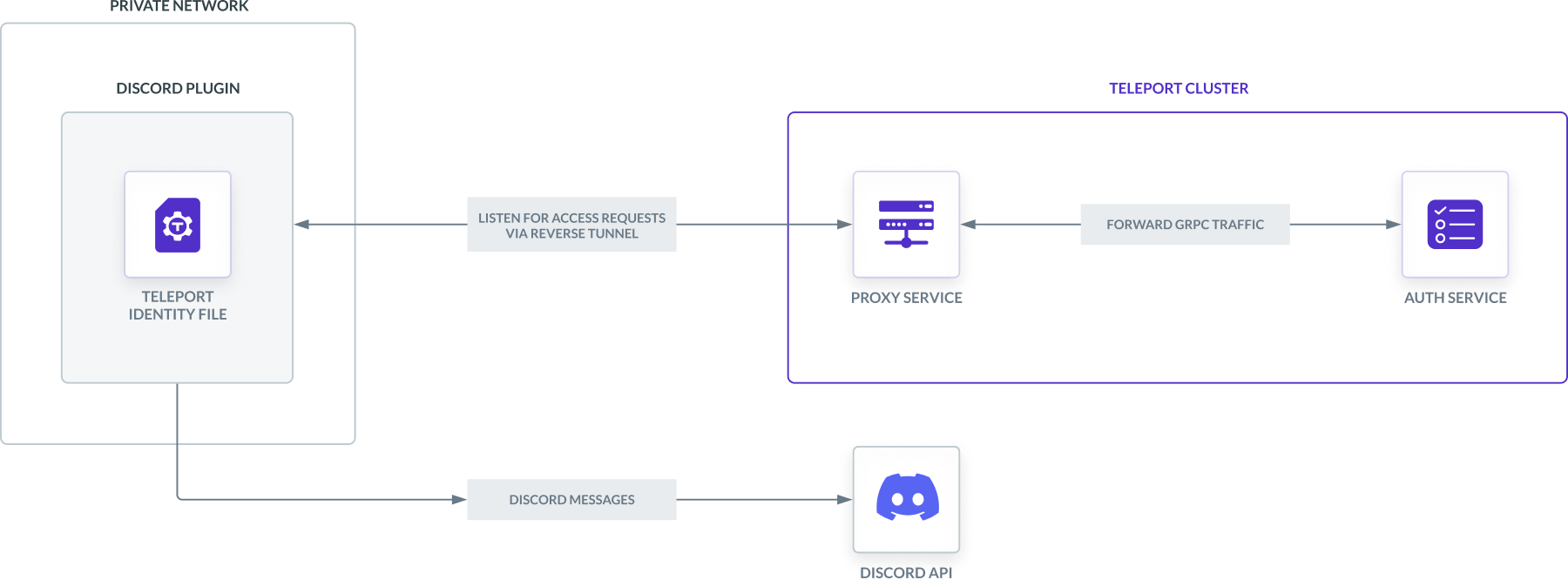
This integration is hosted on Teleport Cloud
In Teleport Enterprise Cloud, Teleport manages the Discord integration for you, and you can enroll the Discord integration from the Teleport Web UI.
Visit the Teleport Web UI and click Access Management on the menu bar at the top of the screen.
On the left sidebar, click Enroll New Integration to visit the "Enroll New Integration" page:
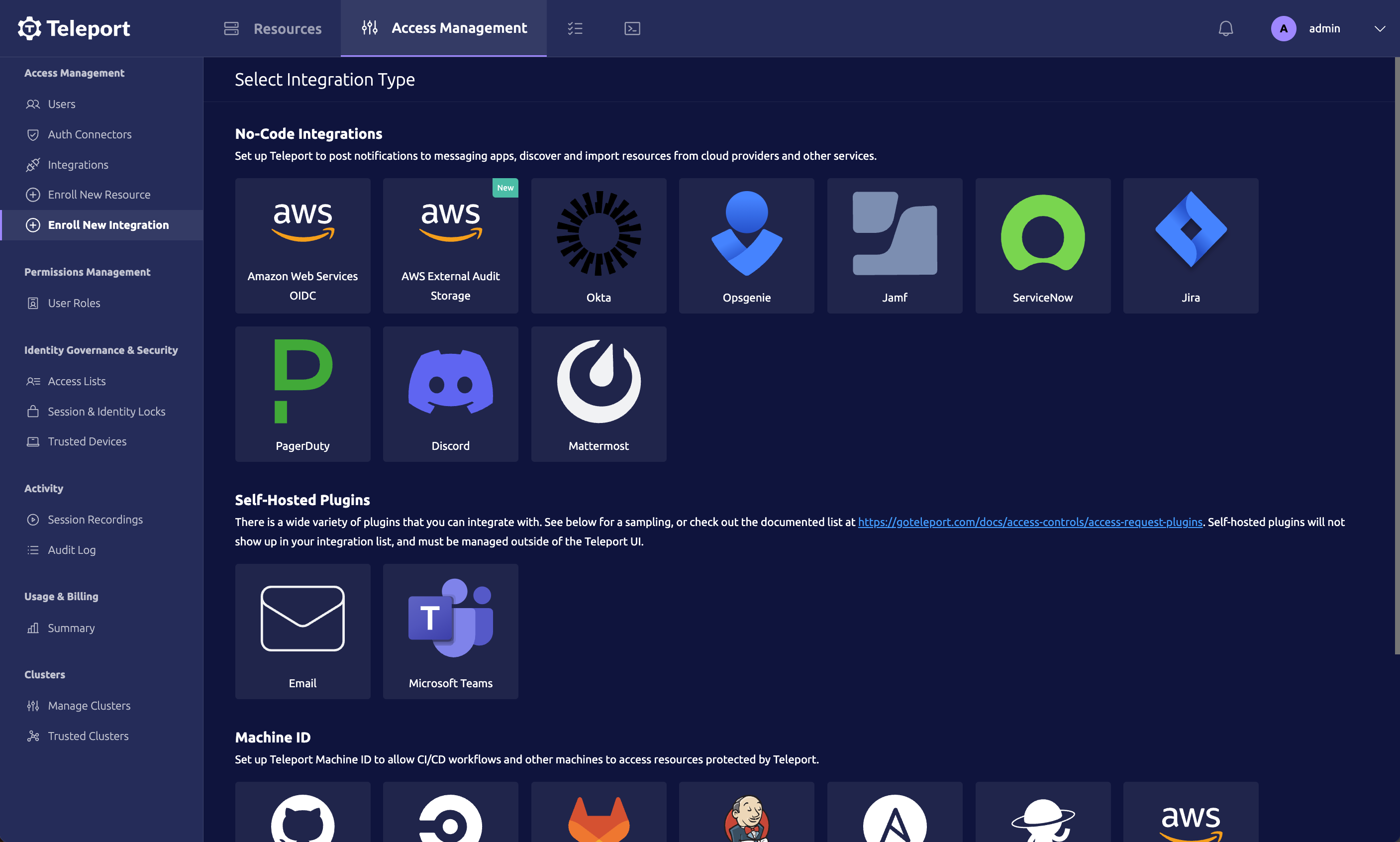
On the "Select Integration Type" menu, click the tile for your integration. You will see a page with instructions to set up the integration, as well as a form that you can use to configure the integration.
Prerequisites
-
A running Teleport cluster. If you want to get started with Teleport, sign up for a free trial.
-
The Enterprise
tctladmin tool andtshclient tool version >= 15.4.22, which you can download from your Teleport account workspace or the Teleport Installation Downloads page.
Recommended: Configure Machine ID to provide short-lived Teleport
credentials to the plugin. Before following this guide, follow a Machine ID
deployment guide
to run the tbot binary on your infrastructure.
- Admin account on your Discord server. Installing a bot requires at least the "manager server" permission.
- Either a Linux host or Kubernetes cluster where you will run the Discord plugin.
- To check that you can connect to your Teleport cluster, sign in with
tsh login, then verify that you can runtctlcommands using your current credentials.tctlis supported on macOS and Linux machines. For example:If you can connect to the cluster and run the$ tsh login --proxy=teleport.example.com --user=email@example.com
$ tctl status
# Cluster teleport.example.com
# Version 15.4.22
# CA pin sha256:abdc1245efgh5678abdc1245efgh5678abdc1245efgh5678abdc1245efgh5678tctl statuscommand, you can use your current credentials to run subsequenttctlcommands from your workstation. If you host your own Teleport cluster, you can also runtctlcommands on the computer that hosts the Teleport Auth Service for full permissions.
Step 1/8. Define RBAC resources
Before you set up the Discord plugin, you will need to enable Role Access Requests in your Teleport cluster.
For the purpose of this guide, we will define an editor-requester role, which
can request the built-in editor role, and an editor-reviewer role that can
review requests for the editor role.
Create a file called editor-request-rbac.yaml with the following content:
kind: role
version: v5
metadata:
name: editor-reviewer
spec:
allow:
review_requests:
roles: ['editor']
---
kind: role
version: v5
metadata:
name: editor-requester
spec:
allow:
request:
roles: ['editor']
thresholds:
- approve: 1
deny: 1
Create the roles you defined:
$ tctl create -f editor-request-rbac.yaml
role 'editor-reviewer' has been created
role 'editor-requester' has been created
Allow yourself to review requests by users with the editor-requester role by
assigning yourself the editor-reviewer role.
Assign the editor-reviewer role to your Teleport user by running the appropriate
commands for your authentication provider:
- Local User
- GitHub
- SAML
- OIDC
-
Retrieve your local user's roles as a comma-separated list:
$ ROLES=$(tsh status -f json | jq -r '.active.roles | join(",")') -
Edit your local user to add the new role:
$ tctl users update $(tsh status -f json | jq -r '.active.username') \
--set-roles "${ROLES?},editor-reviewer" -
Sign out of the Teleport cluster and sign in again to assume the new role.
-
Retrieve your
githubauthentication connector:$ tctl get github/github --with-secrets > github.yamlNote that the
--with-secretsflag adds the value ofspec.signing_key_pair.private_keyto thegithub.yamlfile. Because this key contains a sensitive value, you should remove the github.yaml file immediately after updating the resource. -
Edit
github.yaml, addingeditor-reviewerto theteams_to_rolessection.The team you should map to this role depends on how you have designed your organization's role-based access controls (RBAC). However, the team must include your user account and should be the smallest team possible within your organization.
Here is an example:
teams_to_roles:
- organization: octocats
team: admins
roles:
- access
+ - editor-reviewer -
Apply your changes:
$ tctl create -f github.yaml -
Sign out of the Teleport cluster and sign in again to assume the new role.
-
Retrieve your
samlconfiguration resource:$ tctl get --with-secrets saml/mysaml > saml.yamlNote that the
--with-secretsflag adds the value ofspec.signing_key_pair.private_keyto thesaml.yamlfile. Because this key contains a sensitive value, you should remove the saml.yaml file immediately after updating the resource. -
Edit
saml.yaml, addingeditor-reviewerto theattributes_to_rolessection.The attribute you should map to this role depends on how you have designed your organization's role-based access controls (RBAC). However, the group must include your user account and should be the smallest group possible within your organization.
Here is an example:
attributes_to_roles:
- name: "groups"
value: "my-group"
roles:
- access
+ - editor-reviewer -
Apply your changes:
$ tctl create -f saml.yaml -
Sign out of the Teleport cluster and sign in again to assume the new role.
-
Retrieve your
oidcconfiguration resource:$ tctl get oidc/myoidc --with-secrets > oidc.yamlNote that the
--with-secretsflag adds the value ofspec.signing_key_pair.private_keyto theoidc.yamlfile. Because this key contains a sensitive value, you should remove the oidc.yaml file immediately after updating the resource. -
Edit
oidc.yaml, addingeditor-reviewerto theclaims_to_rolessection.The claim you should map to this role depends on how you have designed your organization's role-based access controls (RBAC). However, the group must include your user account and should be the smallest group possible within your organization.
Here is an example:
claims_to_roles:
- name: "groups"
value: "my-group"
roles:
- access
+ - editor-reviewer -
Apply your changes:
$ tctl create -f oidc.yaml -
Sign out of the Teleport cluster and sign in again to assume the new role.
Create a user called myuser who has the editor-requester role. This user
cannot edit your cluster configuration unless they request the editor role:
$ tctl users add myuser --roles=editor-requester
tctl will print an invitation URL to your terminal. Visit the URL and log in
as myuser for the first time, registering credentials as configured for your
Teleport cluster.
Later in this guide, you will have myuser request the editor role so you can
review the request using the Teleport plugin.
Step 2/8. Install the Teleport Discord plugin
- Download
- Docker Image
- From Source
- Helm Chart
We currently only provide linux-amd64 binaries. You can also compile these
plugins from source. You can run the plugin from a remote host or your local
development machine.
$ curl -L -O https://get.gravitational.com/teleport-access-discord-v15.4.22-linux-amd64-bin.tar.gz
$ tar -xzf teleport-access-discord-v15.4.22-linux-amd64-bin.tar.gz
$ cd teleport-access-discord
$ sudo ./install
Make sure the binary is installed:
$ teleport-discord version
teleport-discord v15.4.22 git:teleport-discord-v15.4.22-fffffffff go1.21
We currently only provide Docker images for linux-amd64.
Pull the Docker image for the latest access request plugin by running the following command:
$ docker pull public.ecr.aws/gravitational/teleport-plugin-discord:15.4.22
Make sure the plugin is installed by running the following command:
$ docker run public.ecr.aws/gravitational/teleport-plugin-discord:15.4.22 version
teleport-discord v15.4.22 git:teleport-discord-v15.4.22-api/14.0.0-gd1e081e 1.21
For a list of available tags, visit Amazon ECR Public Gallery.
To install from source you need git and go installed. If you do not have Go
installed, visit the Go downloads page.
$ git clone https://github.com/gravitational/teleport -b branch/v15
$ cd teleport/integrations/access/discord
$ git checkout 15.4.22
$ make
Move the teleport-discord binary into your PATH.
Make sure the binary is installed:
$ teleport-discord version
teleport-discord v15.4.22 git:teleport-discord-v15.4.22-fffffffff go1.21
Allow Helm to install charts that are hosted in the Teleport Helm repository:
$ helm repo add teleport https://charts.releases.teleport.dev
Update the cache of charts from the remote repository:
$ helm repo update
Step 3/8. Create a user and role for the plugin
Teleport's Access Request plugins authenticate to your Teleport cluster as a user with permissions to list and read Access Requests. This way, plugins can retrieve Access Requests from the Teleport Auth Service and present them to reviewers.
Define a user and role called access-plugin by adding the following content to
a file called access-plugin.yaml:
kind: role
version: v5
metadata:
name: access-plugin
spec:
allow:
rules:
- resources: ['access_request']
verbs: ['list', 'read']
- resources: ['access_plugin_data']
verbs: ['update']
---
kind: user
metadata:
name: access-plugin
spec:
roles: ['access-plugin']
version: v2
Create the user and role:
$ tctl create -f access-plugin.yaml
As with all Teleport users, the Teleport Auth Service authenticates the
access-plugin user by issuing short-lived TLS credentials. In this case, we
will need to request the credentials manually by impersonating the
access-plugin role and user.
If you are running a self-hosted Teleport Enterprise deployment and are using
tctl from the Auth Service host, you will already have impersonation
privileges.
To grant your user impersonation privileges for access-plugin, define a role
called access-plugin-impersonator by pasting the following YAML document into
a file called access-plugin-impersonator.yaml:
kind: role
version: v5
metadata:
name: access-plugin-impersonator
spec:
allow:
impersonate:
roles:
- access-plugin
users:
- access-plugin
Create the access-plugin-impersonator role:
$ tctl create -f access-plugin-impersonator.yaml
If you are providing identity files to the plugin with Machine ID, assign the
access-plugin role to the Machine ID bot user. Otherwise, assign this role to
the user you plan to use to generate credentials for the access-plugin role
and user:
Assign the access-plugin-impersonator role to your Teleport user by running the appropriate
commands for your authentication provider:
- Local User
- GitHub
- SAML
- OIDC
-
Retrieve your local user's roles as a comma-separated list:
$ ROLES=$(tsh status -f json | jq -r '.active.roles | join(",")') -
Edit your local user to add the new role:
$ tctl users update $(tsh status -f json | jq -r '.active.username') \
--set-roles "${ROLES?},access-plugin-impersonator" -
Sign out of the Teleport cluster and sign in again to assume the new role.
-
Retrieve your
githubauthentication connector:$ tctl get github/github --with-secrets > github.yamlNote that the
--with-secretsflag adds the value ofspec.signing_key_pair.private_keyto thegithub.yamlfile. Because this key contains a sensitive value, you should remove the github.yaml file immediately after updating the resource. -
Edit
github.yaml, addingaccess-plugin-impersonatorto theteams_to_rolessection.The team you should map to this role depends on how you have designed your organization's role-based access controls (RBAC). However, the team must include your user account and should be the smallest team possible within your organization.
Here is an example:
teams_to_roles:
- organization: octocats
team: admins
roles:
- access
+ - access-plugin-impersonator -
Apply your changes:
$ tctl create -f github.yaml -
Sign out of the Teleport cluster and sign in again to assume the new role.
-
Retrieve your
samlconfiguration resource:$ tctl get --with-secrets saml/mysaml > saml.yamlNote that the
--with-secretsflag adds the value ofspec.signing_key_pair.private_keyto thesaml.yamlfile. Because this key contains a sensitive value, you should remove the saml.yaml file immediately after updating the resource. -
Edit
saml.yaml, addingaccess-plugin-impersonatorto theattributes_to_rolessection.The attribute you should map to this role depends on how you have designed your organization's role-based access controls (RBAC). However, the group must include your user account and should be the smallest group possible within your organization.
Here is an example:
attributes_to_roles:
- name: "groups"
value: "my-group"
roles:
- access
+ - access-plugin-impersonator -
Apply your changes:
$ tctl create -f saml.yaml -
Sign out of the Teleport cluster and sign in again to assume the new role.
-
Retrieve your
oidcconfiguration resource:$ tctl get oidc/myoidc --with-secrets > oidc.yamlNote that the
--with-secretsflag adds the value ofspec.signing_key_pair.private_keyto theoidc.yamlfile. Because this key contains a sensitive value, you should remove the oidc.yaml file immediately after updating the resource. -
Edit
oidc.yaml, addingaccess-plugin-impersonatorto theclaims_to_rolessection.The claim you should map to this role depends on how you have designed your organization's role-based access controls (RBAC). However, the group must include your user account and should be the smallest group possible within your organization.
Here is an example:
claims_to_roles:
- name: "groups"
value: "my-group"
roles:
- access
+ - access-plugin-impersonator -
Apply your changes:
$ tctl create -f oidc.yaml -
Sign out of the Teleport cluster and sign in again to assume the new role.
You will now be able to generate signed certificates for the access-plugin
role and user.
Step 4/8. Export the access plugin identity
Give the plugin access to a Teleport identity file. We recommend using Machine
ID for this in order to produce short-lived identity files that are less
dangerous if exfiltrated, though in demo deployments, you can generate
longer-lived identity files with tctl:
- Machine ID
- Long-lived identity files
Configure tbot with an output that will produce the credentials needed by
the plugin. As the plugin will be accessing the Teleport API, the correct
output type to use is identity.
For this guide, the directory destination will be used. This will write these
credentials to a specified directory on disk. Ensure that this directory can
be written to by the Linux user that tbot runs as, and that it can be read by
the Linux user that the plugin will run as.
Modify your tbot configuration to add an identity output.
If running tbot on a Linux server, use the directory output to write
identity files to the /opt/machine-id directory:
outputs:
- type: identity
destination:
type: directory
# For this guide, /opt/machine-id is used as the destination directory.
# You may wish to customize this. Multiple outputs cannot share the same
# destination.
path: /opt/machine-id
If running tbot on Kubernetes, write the identity file to Kubernetes secret
instead:
outputs:
- type: identity
destination:
type: kubernetes_secret
name: teleport-plugin-discord-identity
If operating tbot as a background service, restart it. If running tbot in
one-shot mode, execute it now.
You should now see an identity file under /opt/machine-id or a Kubernetes
secret named teleport-plugin-discord-identity. This contains the private key and signed
certificates needed by the plugin to authenticate with the Teleport Auth
Service.
Like all Teleport users, access-plugin needs signed credentials in order to
connect to your Teleport cluster. You will use the tctl auth sign command to
request these credentials.
The following tctl auth sign command impersonates the access-plugin user,
generates signed credentials, and writes an identity file to the local
directory:
$ tctl auth sign --user=access-plugin --out=identity
The plugin connects to the Teleport Auth Service's gRPC endpoint over TLS.
The identity file, identity, includes both TLS and SSH credentials. The
plugin uses the SSH credentials to connect to the Proxy Service, which
establishes a reverse tunnel connection to the Auth Service. The plugin
uses this reverse tunnel, along with your TLS credentials, to connect to the
Auth Service's gRPC endpoint.
Certificate Lifetime
By default, tctl auth sign produces certificates with a relatively short
lifetime. For production deployments, we suggest using Machine
ID to programmatically issue and renew
certificates for your plugin. See our Machine ID getting started
guide to learn more.
Note that you cannot issue certificates that are valid longer than your existing credentials.
For example, to issue certificates with a 1000-hour TTL, you must be logged in with a session that is
valid for at least 1000 hours. This means your user must have a role allowing
a max_session_ttl of at least 1000 hours (60000 minutes), and you must specify a --ttl
when logging in:
$ tsh login --proxy=teleport.example.com --ttl=60060
If you are running the plugin on a Linux server, create a data directory to hold certificate files for the plugin:
$ sudo mkdir -p /var/lib/teleport/api-credentials
$ sudo mv identity /var/lib/teleport/plugins/api-credentials
If you are running the plugin on Kubernetes, Create a Kubernetes secret that contains the Teleport identity file:
$ kubectl -n teleport create secret generic --from-file=identity teleport-plugin-discord-identity
Once the Teleport credentials expire, you will need to renew them by running the
tctl auth sign command again.
Step 5/8. Register a Discord app
The Access Request plugin for Discord receives Access Request events from the Teleport Auth Service, formats them into Discord messages, and sends them to the Discord API to post them in your guild (Discord server). For this to work, you must register a new app with the Discord API.
Create your application
Visit https://discord.com/developers/applications to create a new Discord application. Click "New Application" and name the application "Teleport".
Set the application icon (download application icon here).
Create the application bot
Go to the "Bot" tab and choose "Add Bot". Set the bot icon (download bot icon here). Un-check the "Public Bot" toggle as this bot should only be used within your Discord servers. Finally, press "Reset Token", copy and save the new token into a safe place. This token will be used by the Teleport plugin to authenticate against the Discord API.
Install and authorize the application in your Discord server
Go the the "OAuth2" tab, open the "URL Generator" and check the "bot" and "Send Messages" permissions.
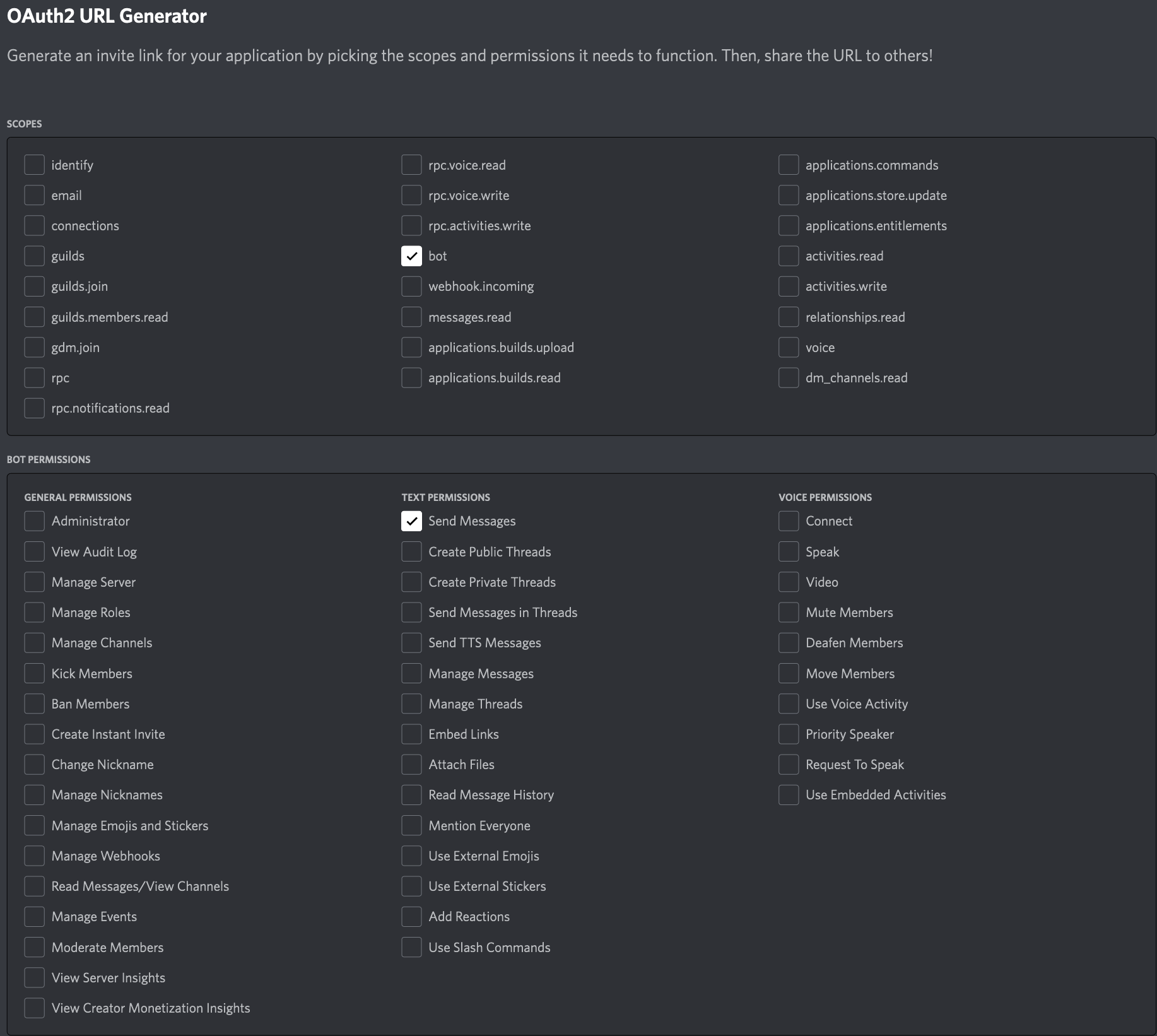
Copy and access the generated URL. Choose to install the application into the desired Discord server. If the server is not available in the dropdown list, it means you don't have sufficient rights. Ask a server administrator to grant you a role with the "manage server" permission.
The same application can be installed into multiple Discord servers. To do so, access the OAuth URL multiple times and choose different servers. You have to be admin on a Discord server to install the app into it.
Step 6/8. Configure the Teleport Discord plugin
At this point, the Teleport Discord plugin has the credentials it needs to communicate with your Teleport cluster and the Discord API. In this step, you will configure the Discord plugin to use these credentials. You will also configure the plugin to notify the right Discord channels when it receives an Access Request update.
Create a config file
- Executable or Docker
- Helm Chart
The Teleport Discord plugin uses a config file in TOML format. Generate a
boilerplate config by running the following command (the plugin will not run
unless the config file is in /etc/teleport-discord.toml):
$ teleport-discord configure | sudo tee /etc/teleport-discord.toml > /dev/null
This should result in a config file like the one below:
(!examples/resources/plugins/teleport-discord.toml!)
The Discord Helm chart uses a YAML values file to configure the plugin.
On your local workstation, create a file called teleport-discord-helm.yaml
based on the following example:
(!examples/resources/plugins/teleport-discord-helm.yaml!)
Edit the config file
Open the configuration file created for the Teleport Discord plugin and update the following fields:
[teleport]
The Discord plugin uses this section to connect to the Teleport Auth Service.
- Executable or Docker
- Helm Chart
addr: Include the hostname and HTTPS port of your Teleport Proxy Service
or Teleport Enterprise Cloud account (e.g., teleport.example.com:443 or
mytenant.teleport.sh:443).
identity: Fill this in with the path to the identity file you exported
earlier.
client_key, client_crt, root_cas: Comment these out, since we
are not using them in this configuration.
address: Include the hostname and HTTPS port of your Teleport Proxy Service
or Teleport Enterprise Cloud tenant (e.g., teleport.example.com:443 or
mytenant.teleport.sh:443).
identitySecretName: Fill in the identitySecretName field with the name
of the Kubernetes secret you created earlier.
identitySecretPath: Fill in the identitySecretPath field with the path
of the identity file within the Kubernetes secret. If you have followed the
instructions above, this will be identity.
If you are providing credentials to the plugin using a tbot binary that runs
on a Linux server, make sure the value of identity is the same as the path of
the identity file you configured tbot to generate, /opt/machine-id/identity.
Configure the plugin to periodically reload the identity file, ensuring that it does not attempt to connect to the Teleport Auth Service with expired credentials.
Add the following to the teleport section of the configuration:
refresh_identity = true
[discord]
token: Paste the bot token saved previously in this field.
[role_to_recipients]
The role_to_recipients map configures the channels that the Discord plugin will
notify when a user requests access to a specific role. When the Discord plugin
receives an Access Request from the Auth Service, it will look up the role being
requested and identify the Discord channels to notify.
Each channel is represented by a numeric ID. Channels can be public, private or direct messages between a user and the bot. To determine the numeric ID of a channel for the bot to notify, follow the instructions below:
- Public Channel
- Private Channel
- Direct Message
Open Discord in a web browser and navigate to the desired channel.
The web browser URL should look like:
https://discord.com/channels/<guild ID>/<channel ID>
Copy the last part of the URL (everything after the last /), which is the channel ID.
Open Discord in a web browser and navigate to the desired channel.
In the channel list choose "Create invite", type "teleport" in the search field and invite your Discord Teleport bot. The bot should now appear in the channel member list.
The web browser URL should look like:
https://discord.com/channels/<guild ID>/<channel ID>
Copy the last part of the URL (everything after the last /), which is the channel ID.
To retrieve the channel ID of the private discussion between User A and the Teleport bot, have User A send a direct message to the Teleport bot. This will open a conversation between the user and the bot. Once the conversation is initiated, the user can open the discussion page.
The web browser URL should look like:
https://discord.com/channels/@me/<channel ID>
Copy the last part of the URL (everything after the last /), which is the channel ID.
In the role_to_recipients map, each key is the name of a Teleport role. Each
value configures the Discord channel (or channels) to notify.
The role_to_recipients map must also include an entry for "*", which the
plugin looks up if no other entry matches a given role name. In the example
above, requests for roles aside from dev will notify the
security-team channel.
Configure the Discord plugin to notify you when a user requests the editor role
by adding the following to your role_to_recipients config (replace
YOUR-CHANNEL-ID with a valid channel ID):
- Executable or Docker
- Helm Chart
Here is an example of a role_to_recipients map. Each value can be a single
string or an array of strings:
[role_to_recipients]
"*" = "YOUR-CHANNEL-ID"
"editor" = "YOUR-CHANNEL-ID"
In the Helm chart, the role_to_recipients field is called roleToRecipients
and uses the following format, where keys are strings and values are arrays of
strings:
roleToRecipients:
"*": ["YOUR-CHANNEL-ID"]
"editor": ["YOUR-CHANNEL-ID"]
The final configuration file should resemble the following:
- Executable or Docker
- Helm Chart
(!examples/resources/plugins/teleport-discord.toml!)
(!examples/resources/plugins/teleport-discord-helm.yaml!)
Step 7/8. Test your Discord app
Once Teleport is running, you've created the Discord app, and the plugin is configured, you can now run the plugin and test the workflow.
- Executable
- Docker
- Helm Chart
Start the plugin:
$ teleport-discord start
If everything works fine, the log output should look like this:
$ teleport-discord start
INFO Starting Teleport Access Discord Plugin 15.4.22: discord/app.go:80
INFO Plugin is ready discord/app.go:101
Start the plugin:
$ docker run -v <path-to-config>:/etc/teleport-discord.toml public.ecr.aws/gravitational/teleport-plugin-discord:15.4.22 start
Install the plugin:
$ helm upgrade --install teleport-plugin-discord teleport/teleport-plugin-discord --values teleport-discord-helm.yaml
To inspect the plugin's logs, use the following command:
$ kubectl logs deploy/teleport-plugin-discord
Debug logs can be enabled by setting log.severity to DEBUG in
teleport-discord-helm.yaml and executing the helm upgrade ... command
above again. Then you can restart the plugin with the following command:
$ kubectl rollout restart deployment teleport-plugin-discord
Create an Access Request and check if the plugin works as expected with the following steps.
Create an Access Request
- As an Admin
- As a User
- From the Web UI
A Teleport admin can create an Access Request for another user with tctl:
$ tctl request create myuser --roles=editor
Users can use tsh to create an Access Request and log in with approved roles:
$ tsh request create --roles=editor
Seeking request approval... (id: 8f77d2d1-2bbf-4031-a300-58926237a807)
Users can request access using the Web UI by visiting the "Access Requests" tab and clicking "New Request":
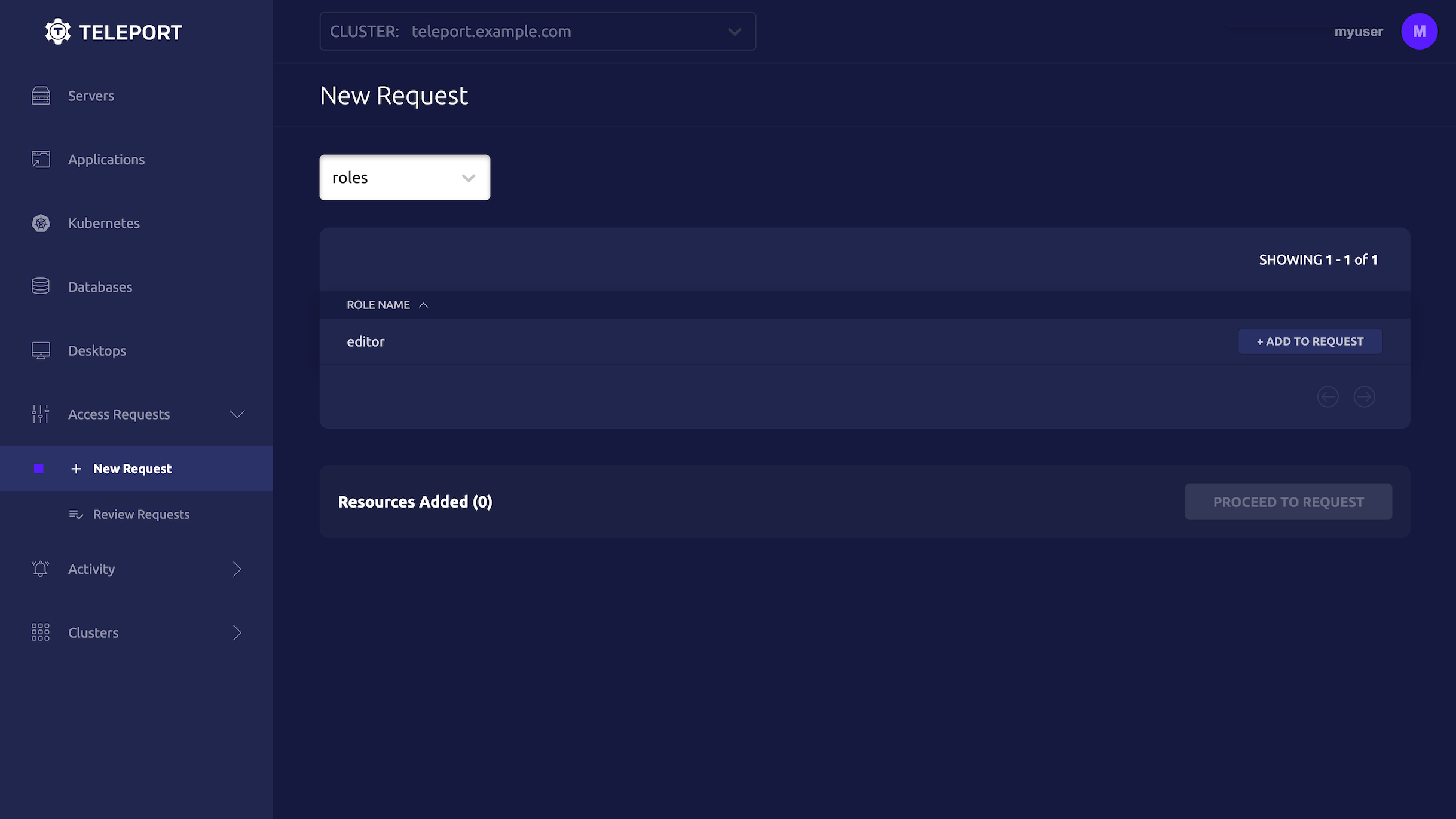
The channel you configured earlier to review the request should receive a message from "Teleport" in Discord allowing them to visit a link in the Teleport Web UI and either approve or deny the request.
Resolve the request
Once you receive an Access Request message, click the link to visit Teleport and approve or deny the request:
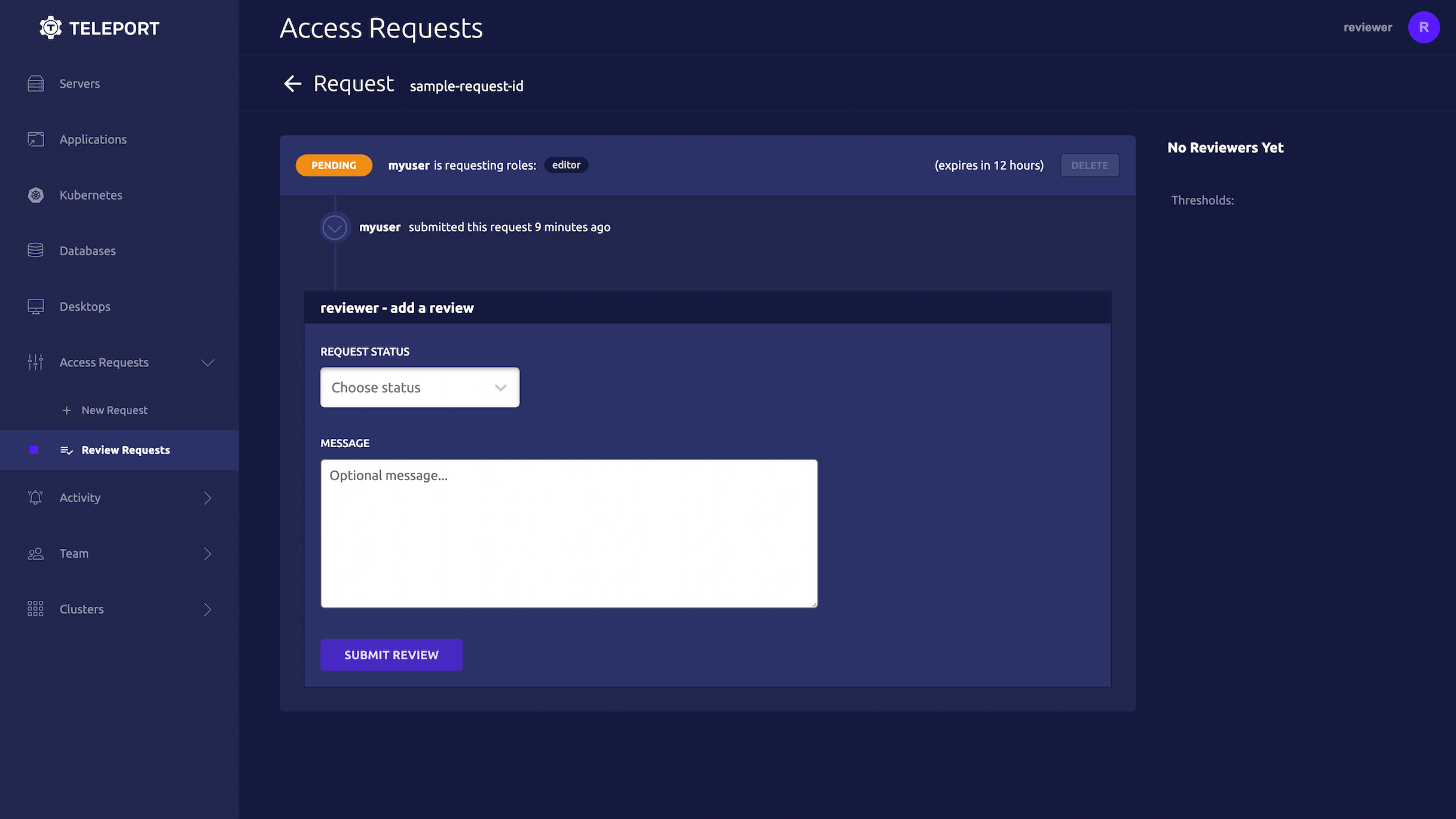
Reviewing from the command line
You can also review an Access Request from the command line:
- As an Admin
- As a User
# Replace REQUEST_ID with the id of the request
$ tctl request approve REQUEST_ID
$ tctl request deny REQUEST_ID
# Replace REQUEST_ID with the id of the request
$ tsh request review --approve REQUEST_ID
$ tsh request review --deny REQUEST_ID
Once the request is resolved, the Discord bot will update the access request message with ✅ or ❌, depending on whether the request was approved or denied.
When the Discord plugin posts an Access Request notification to a channel, anyone with access to the channel can view the notification and follow the link. While users must be authorized via their Teleport roles to review Access Requests, you should still check the Teleport audit log to ensure that the right users are reviewing the right requests.
When auditing Access Request reviews, check for events with the type Access Request Reviewed in the Teleport Web UI.
Step 8/8. Set up systemd
This section is only relevant if you are running the Teleport Discord plugin on a Linux host.
In production, we recommend starting the Teleport plugin daemon via an init system like systemd. Here's the recommended Teleport plugin service unit file for systemd:
(!examples/systemd/plugins/teleport-discord.service!)
Save this as teleport-discord.service in either /usr/lib/systemd/system/ or
another unit file load
path
supported by systemd.
Enable and start the plugin:
$ sudo systemctl enable teleport-discord
$ sudo systemctl start teleport-discord
Next steps
- Read our guides to configuring Resource Access Requests and Role Access Requests so you can get the most out of your Access Request plugins.